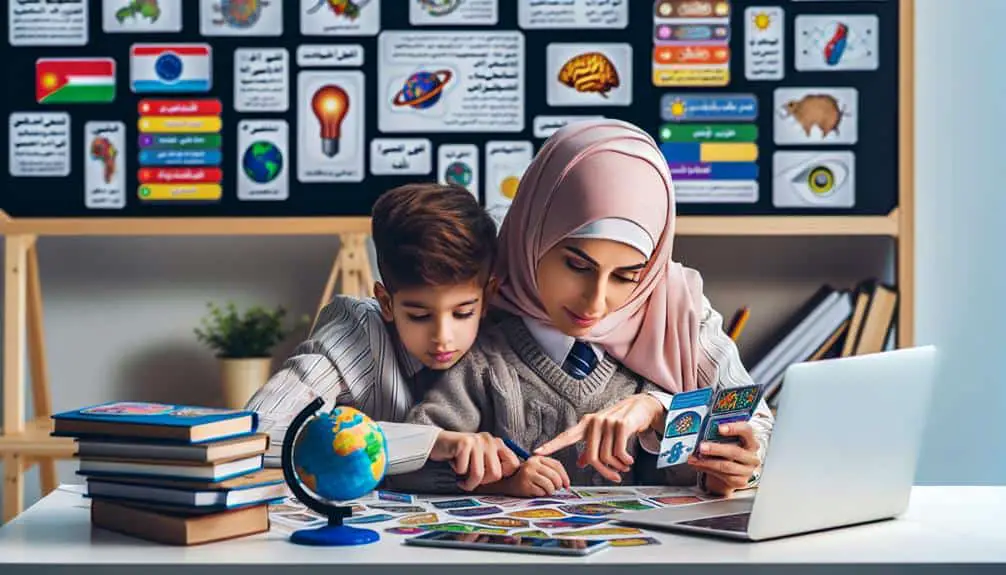Enhancing your homeschool curriculum with hands-on learning is key for boosting engagement and comprehension. Tailor activities to cater to visual learners by using visual aids and interactive materials. Engage kinesthetic learners through hands-on projects that enhance critical thinking. Adapt lessons for auditory learners by incorporating listening-based activities and interactive games. Multi-sensory approaches engage various senses simultaneously, deepening understanding. By incorporating these strategies, you can create a dynamic learning environment that caters to diverse learning styles and maximizes your child's educational experience. More insights await for optimizing your homeschool curriculum!
Key Points
- Integrate hands-on experiments and activities for practical learning experiences.
- Use project-based learning to enhance critical thinking and understanding.
- Incorporate interactive materials to engage kinesthetic learners effectively.
- Include outdoor activities to promote experiential learning.
- Utilize technology for visual and auditory stimulation in homeschool lessons.
Understanding Different Learning Styles
Understanding various learning styles is essential for tailoring educational approaches to individual needs and maximizing learning outcomes. Learning preferences play a critical role in how students process information and engage with educational material. By recognizing that students have unique ways of learning, educators can adapt their teaching strategies to cater to these preferences effectively.
Individualized instruction is a key component of addressing diverse learning styles. By customizing teaching methods based on how students learn best, educators can optimize the learning experience for each individual. This tailored approach fosters better engagement, comprehension, and retention of information.
Effective communication is another significant aspect when considering different learning styles. Clear and concise communication helps students grasp complex concepts more easily. By utilizing various communication techniques, such as visual aids, verbal explanations, and hands-on activities, educators can make sure that they're reaching students with varying learning preferences.
Tailoring Activities to Visual Learners
Tailoring activities to visual learners involves incorporating visual aids and interactive materials to enhance comprehension and engagement in the learning process. Visual aids, such as diagrams, charts, graphs, and videos, can help visual learners better understand complex concepts by providing a visual representation of the information being taught. These aids serve as powerful tools to reinforce key ideas and make abstract topics more tangible.
Hands-on experiments are another effective way to cater to visual learners. By engaging in practical activities, visual learners can directly observe how theories work in real life, leading to a deeper understanding of the subject matter. For example, conducting science experiments or creating visual art projects can help solidify concepts and stimulate visual learners' curiosity and creativity.
When tailoring activities for visual learners, it's essential to provide a variety of visual aids and hands-on experiences to accommodate different learning preferences. By incorporating these strategies into homeschool curriculum, visual learners can maximize their learning potential and actively participate in their educational journey.
Engaging Kinesthetic Learners With Projects
To effectively engage kinesthetic learners in homeschool curriculum, incorporating hands-on projects that emphasize physical interaction and movement is key. Project-based learning provides an excellent opportunity for kinesthetic learners to actively engage with the material. Through hands-on activities, such as building models, conducting experiments, or creating art projects, kinesthetic learners can better understand and retain information. These projects not only cater to their learning style but also enhance their critical thinking and problem-solving skills.
Hands-on activities allow kinesthetic learners to explore concepts through touch, movement, and manipulation, which can lead to a deeper comprehension of the subject matter. By incorporating hands-on projects into the curriculum, parents can create a dynamic learning environment that caters to the needs of kinesthetic learners. Whether it's through science experiments, role-playing scenarios, or outdoor exploration, these hands-on activities provide a stimulating way for kinesthetic learners to interact with the material. Overall, integrating project-based learning and hands-on activities into homeschool curriculum can greatly enhance the educational experience for kinesthetic learners.
Adapting Lessons for Auditory Learners
Adapting lessons for auditory learners involves incorporating listening-based activities that enhance comprehension and retention of educational material. For auditory learners, group discussions can be highly beneficial. Engaging in conversations allows them to verbalize their thoughts, actively listen to others, and process information through auditory channels.
Interactive games are another effective tool for auditory learners. Games that involve listening to instructions, following oral cues, or participating in audio-based quizzes can help reinforce learning in a fun and engaging way. Additionally, incorporating podcasts, audiobooks, or educational videos can cater to their preference for auditory input.
Incorporating Multisensory Approaches
Incorporating multisensory approaches into homeschool curriculum can greatly enhance the learning experience for students by engaging multiple senses simultaneously, promoting deeper understanding and retention of educational material. When students engage in sensory exploration and interactive experiences, they're more likely to grasp complex concepts and remember information for longer periods.
Here are three ways to incorporate multisensory approaches into your homeschool curriculum:
- Hands-On Activities: Encourage tactile learning through hands-on projects like science experiments, art activities, or building models. These activities not only cater to kinesthetic learners but also stimulate other senses, making learning more engaging and memorable.
- Use of Technology: Incorporate educational apps, virtual reality experiences, or interactive simulations to provide visual and auditory stimulation alongside traditional reading and writing tasks. This approach can help cater to different learning styles and enhance overall comprehension.
- Outdoor Learning: Take learning outside with nature walks, gardening projects, or outdoor scavenger hunts. Outdoor activities provide a rich sensory experience, allowing students to connect with the material in a unique and memorable way.




